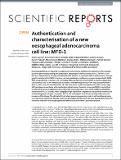Authentication and characterisation of a new oesophageal adenocarcinoma cell line : MFD-1
Abstract
New biological tools are required to understand the functional significance of genetic events revealed by whole genome sequencing (WGS) studies in oesophageal adenocarcinoma (OAC). The MFD-1 cell line was isolated from a 55-year-old male with OAC without recombinant-DNA transformation. Somatic genetic variations from MFD-1, tumour, normal oesophagus, and leucocytes were analysed with SNP6. WGS was performed in tumour and leucocytes. RNAseq was performed in MFD-1, and two classic OAC cell lines FLO1 and OE33. Transposase-accessible chromatin sequencing (ATAC-seq) was performed in MFD-1, OE33, and non-neoplastic HET1A cells. Functional studies were performed. MFD-1 had a high SNP genotype concordance with matched germline/tumour. Parental tumour and MFD-1 carried four somatically acquired mutations in three recurrent mutated genes in OAC: TP53, ABCB1 and SEMA5A, not present in FLO-1 or OE33. MFD-1 displayed high expression of epithelial and glandular markers and a unique fingerprint of open chromatin. MFD-1 was tumorigenic in SCID mouse and proliferative and invasive in 3D cultures. The clinical utility of whole genome sequencing projects will be delivered using accurate model systems to develop molecular-phenotype therapeutics. We have described the first such system to arise from the oesophageal International Cancer Genome Consortium project.
Citation
Garcia , E , Hayden , A , Birts , C , Britton , E , Cowie , A , Pickard , K , Mellone , M , Choh , C , Derouet , M , Duriez , P , Noble , F , White , M J , Primrose , J N , Strefford , J C , Rose-Zerilli , M , Thomas , G J , Ang , Y , Sharrocks , A D , Fitzgerald , R C , Underwood , T J & OCCAMS Consortium 2016 , ' Authentication and characterisation of a new oesophageal adenocarcinoma cell line : MFD-1 ' , Scientific Reports , vol. 6 , 32417 . https://doi.org/10.1038/srep32417
Publication
Scientific Reports
Status
Peer reviewed
ISSN
2045-2322Type
Journal article
Collections
Items in the St Andrews Research Repository are protected by copyright, with all rights reserved, unless otherwise indicated.

